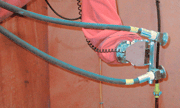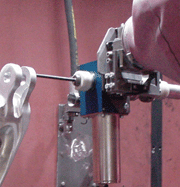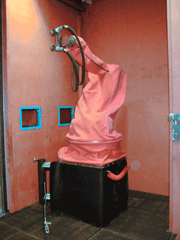E-Archive
Articles
in Vol. 4 - May Issue - Year 2003
Robotic Peening Applications at its Best

Author: Max Gutknecht, Chief Engineer at Baiker AG

Pneumatic "Grip" used to hold the requested peening tool

Robot equipped with 2 external peening nozzles

Robot with large internal peening head

The use of robots within peening machines has certainly gained popularity. This for a number of reasons. The manufacturers of robots have made the integration of their systems into others increasingly easy. Furthermore, looking at a certain level of performance, the robots became considerably smaller in dimensions and the teach-in style of programming makes it easy for the operator to handle it.
For certain peening applications robot solutions seem to be the perfect answer. With its 6 axis, the flexibility is certainly an advantage, especially if the robot is mounted on a small moveable platform, which still could move in 2 additional axis. The accuracy and repeatability of its movement are below 1/10 of a mm, which is by far sufficient for the peening process. Furthermore, the whole cabin design is much simpler, since no nozzle shafts have to move along a cabin ceiling or cabin side wall. However, since the complete robot has to be fitted into the cabin, the size of the cabin will be considerable larger.
How to decide for or against a Robot Peening Machine?
It is not always easy to make this decision. That is why in some cases computer simulations are carried out ahead of time to prove the suitability of a robot. One has to keep in mind that a robot, which is not installed on a moveable platform, has a relatively limited working envelope. This despite its 6 axis. Also, the maximum weight a robot can carry is easily exceeded. So the perfect application range for such a robot would be smaller, but very complicated parts, which do not have a rotation symmetrical shape and should be treated with a single nozzle. Here the robot can use its flexibility and due to the smaller parts, the robot layout and therefore the cabin will not be too large.
Certainly, a robot can carry more than 1 or 2 standard nozzles. However, the advantage of its flexibility is jeopardized if a robot is used to move a nozzle arrangement of 3 or 4 nozzles. An accurate peening is then hardly possible. Applications for which it makes sense to use 3 or 4 nozzles at the time are usually of a simpler nature and do not need the use of a sophisticated robot.
Robot Protection
The protection of the robot against the extremely abrasive surrounding inside a peening cabinet is a very demanding task. Almost 15-20% of the robot costs are spent on its protection.
The rubber protection has to be flexible enough not to hinder its movement, however, still needs to be strong enough to outlast the abrasive peening media. In the case of the Swiss manufacturer Baiker AG, the sealed rubber protection of the robot is inflated by air pressure. The pressure of the air between the robot and its protection is measured and supervised at all time. Should there be any leakage, the air pressure drop will be identified and on request the machine can be turned off.
Nozzle Exchange Station
The robot can be equipped with a pneumatically driven grip device, which always gets the requested peening tool by itself. The Swiss company has designed nozzle stations, where the robot will have a choice between different sizes of internal peening heads, standard nozzles and custom designed nozzles. That allows automated changing of nozzle without an interruption of the peening program.
Conclusion
All in all a buyer of a new peening machine should carefully evaluate the possible parts to be treated in the future. Based on that and the recommendation of the manufacturer the right nozzle movement system should be chosen.
For information:
Baiker AG
Dry & Wet Peening and Blasting Technology
Alpenstrasse 1
8152 Glattbrugg, Switzerland
Tel: +41.43.2116272
Fax: +41.43.2116271
E-mail: info@baiker.ch
www.baiker.ch



























